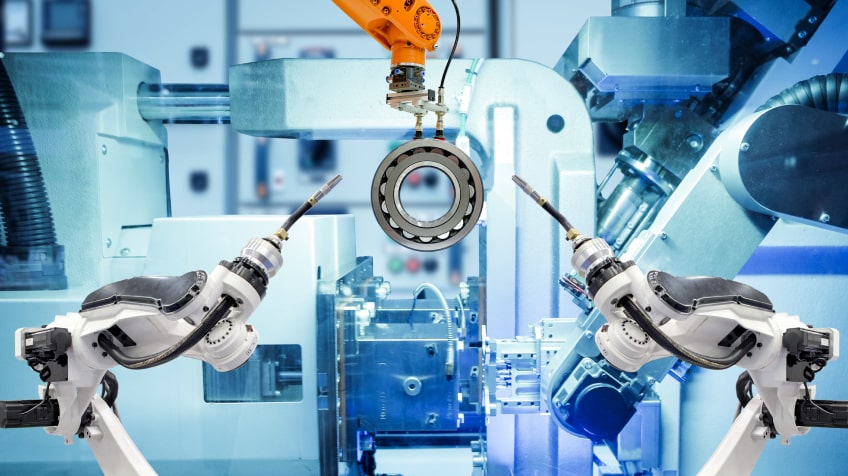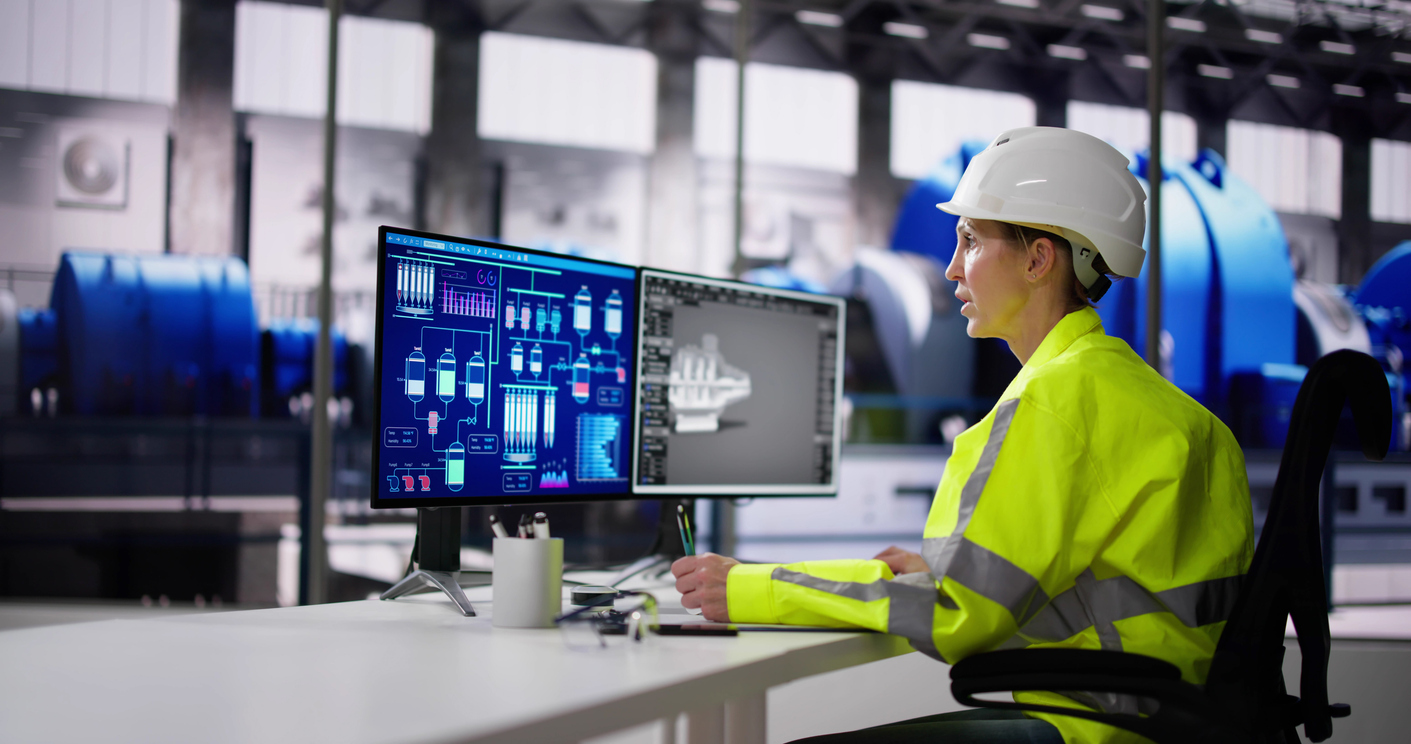In manufacturing, robots are taking over the world. Or, at least, that’s what we’re led to believe.
In the manufacturing sector, sustainable growth largely depends on a company’s ability to innovate and embrace digital transformation. As a result, the integration of industrial robots has been revolutionary in digital factory engineering, as well as other industries.
The digital factory is the industrial sector’s big bet for the future, and we are seeing a major shift in employment here.
On the one hand, people view artificial intelligence (AI) and robots as a problem because they are replacing menial work. More than 50% of US jobs are predicted to be impacted by automation over the next 20 years in sectors like manufacturing, retail, inspection, and delivery.
On the other hand, key findings from a Pew Research study on “AI, Robotics and The Future of Jobs” indicates that 52% of respondents view the integration of industrial robots as the perfect opportunity to get people into more creative positions by freeing their hands from menial, assembly line work.
So, are industrial robots killing jobs or creating better ones?
Before discussing this question, we should first understand how industrial robots impact the manufacturing sector. It is important to look at this trend from both a macro and micro perspective to get an accurate picture of future employment.
The impact of industrial robots in manufacturing
On a macro level, McKinsey & Company’s research on “The Future of Jobs: Working in 2030” indicates that while the manufacturing sector is predicted to remain an important source of employment in 2021, there will be a decrease in direct and indirect labor.
McKinsey says that “the number of people required to manufacture products will drop by 20% to 25% by 2025” and this industry is expected to lose 8% of its employees over the same period. These findings are similar to those of an Oxford Economics study that predicts manufacturing jobs will decrease by 20 million by 2030.
On a micro level, job-level data from global companies show that industrial robots are already affecting individual companies and their workforce today.
Data and analytics company Smart Cube conducted analysis on the employment data of 10 manufacturing companies from different industries in North America and Europe. The study revealed that, when comparing two similar plants with one using industrial robots and the other having no automation, on average there is a reduction of 38% in direct labor rate (the number of employees required to produce a given output).
So, what does this mean for human workers?
There are two kinds of manufacturing: Labor-Intensive and Capital-Intensive
Labor-intensive typically means low wages, poor working conditions, and very little investment in technology. Conversely, capital-intensive means high wages, good working conditions, and heavy investment in robotics.
The biggest takeaway is that employees in high-skilled engineering jobs benefit from using robots, while low-skilled workers lose their jobs because they cannot compete with a robot’s speed. However, in a capital-intensive environment, robots create new jobs by performing menial tasks for those with higher-level positions.
Here are some new job roles resulting from the integration of industrial robots:
New types of workers:
- Automation technicians
- Robot programmers
- Homebuilders who understand smart systems and how they work
- Architects who can understand the safety, structure, and flow of buildings with automation,
- Smart home system designers
New types of managers:
- Business owners who can run automated construction companies where all machines are controlled by A.I.,
- Engineers who can design homes with integrated smart systems
New support staff:
- Data scientists to collect information about customer preferences and optimize smart systems for them
- Engineers and data scientists who develop new smart systems
Robotics as an enabler of new jobs in automotive and electronics
Coined by researchers from Harvard University, “the paradox of automation,” found that adding more robots to a mid-20th century U.S. factory resulted in higher employment overall, not lower — mainly because the added efficiency freed up workers’ to improve products or processes or even create entirely new products.
Another study by the National Bureau of Economic Research found that for every robot introduced into U.S. industries, both high and low skilled occupations increased. And that was not just in the industry where robots were implemented, but throughout the economy as a whole.
Furthermore, the World Economic Forum estimates that automation will create a net gain of 58 million employment opportunities. Around two-thirds of the jobs that will be disrupted by automation will need higher levels of education, while the remaining third will require less.
Industrial robots are expected to have a massive impact on jobs worldwide, but from what we can see so far, the major reduction in manufacturing employment will not create many job opportunities.
However, there are two key industries that will benefit from the impact of industrial robotics: the automotive industry and the electronics manufacturing industry.
The automotive industry and robots
During the first wave of industrial robotics, over 80,000 automotive jobs were lost across the U.S. and Europe due to increased automation. However, it’s important to recognize that there is a positive side to the fact that there are fewer people working on automotive assembly lines.
With industrial robots replacing high-risk assembly line jobs over time, less dangerous roles will be reserved for humans (for example quality assurance positions). Also, robotics in the automotive industry will help create new jobs such as robot technicians and engineers who build, program and maintain robots on the assembly line.
There are over 300,000 robot installations in factories around the world (not including service, automating, or other types of robots). China, Japan, and South Korea account for 70% of these installations. This means the market will keep growing exponentially in the coming years, and the need for robot technicians and engineers will increase.
According to Sokanu, the robotics engineer job market is expected to increase by 6.4 percent between 2016 and 2026. And over the next 10 years, the U.S. alone will need 12,500 engineers in the field.
These technicians will need specific education and training to work in this industry as they will be responsible for maintenance and repairs, teaching co-workers how to program or use a specific robot, and improving current robot models.
Electronics manufacturing and robots
Robots are becoming a major part of the electronics industry, making up nearly as much market share in 2018 as they did for the automotive industry.
This rapid growth is detailed by RIA statistics on global robot shipments, which show that worldwide robotics increased 22% from 2017 to 2018 and now represents one-third of the total supply, according to the World Robotics Report by International Federation of Robots (IFR).
The prevalence of robotics in the electronics sector can be attributed to several factors. First, modern robots are faster, more precise, and provide higher security than any robots in history. A lot of time and effort has been invested in the development of motors, sensors, and electronics.
Second, competition is driving companies to use automation to save on labor costs and improve part quality and production flexibility. Third, companies are building smart factories that use IoT technologies to make automation more efficient in terms of cost and time-to-market.
While the labor vs. capital investment dilemma has been a longtime debate for manufacturers, robotics is quickly emerging as a key enabler of smart factory and Industry 4.0 technologies. Robots can improve how quickly and flexibly goods can be produced, while also freeing up human employees to step away from monotonous tasks and focus on higher-value work such as product design or process enhancement.
The bottom line is that industrial robots are here to stay, not as a substitute for human labor but rather as a complementary force that can free us up to work on more creative activities.
Want to learn more about how HTEC’s technology expertise can transform your business? Explore our Product Engineering and Industrial & Robotics capabilities.






